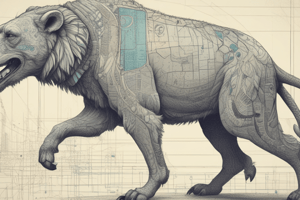Podcast
Questions and Answers
What is the primary goal of operant conditioning?
What is the primary goal of operant conditioning?
- To modify behavior by manipulating consequences (correct)
- To eliminate a conditioned response
- To study the process of classical conditioning
- To associate a stimulus with a response
What type of reinforcer is money?
What type of reinforcer is money?
- Secondary reinforcer (correct)
- Negative reinforcer
- Positive reinforcer
- Primary reinforcer
What is the result of a behavior that is followed by a pleasing consequence?
What is the result of a behavior that is followed by a pleasing consequence?
- The behavior will increase in frequency (correct)
- The behavior will become extinct
- The behavior will remain the same
- The behavior will decrease in frequency
What is the difference between positive reinforcement and negative reinforcement?
What is the difference between positive reinforcement and negative reinforcement?
What is an example of a primary reinforcer?
What is an example of a primary reinforcer?
What is the result of a behavior that is followed by an unpleasant consequence?
What is the result of a behavior that is followed by an unpleasant consequence?
What is the process of gradually modifying behavior through reinforcement?
What is the process of gradually modifying behavior through reinforcement?
What is the purpose of punishment in operant conditioning?
What is the purpose of punishment in operant conditioning?
What is the difference between reinforcement and punishment?
What is the difference between reinforcement and punishment?
What is the result of a behavior that is consistently followed by a reinforcement?
What is the result of a behavior that is consistently followed by a reinforcement?
Flashcards
Negative Reinforcement
Negative Reinforcement
Removal of a stimulus to increase behavior frequency.
Punishment
Punishment
Any stimulus that decreases the frequency of a behavior.
Positive Punishment
Positive Punishment
Addition of a stimulus to decrease behavior.
Negative Punishment
Negative Punishment
Signup and view all the flashcards
Shaping
Shaping
Signup and view all the flashcards
Continuous Reinforcement
Continuous Reinforcement
Signup and view all the flashcards
Fixed-Ratio Schedule
Fixed-Ratio Schedule
Signup and view all the flashcards
Classical Conditioning
Classical Conditioning
Signup and view all the flashcards
Operant Conditioning
Operant Conditioning
Signup and view all the flashcards
Law of Effect
Law of Effect
Signup and view all the flashcards
Study Notes
Reinforcement and Punishment
- Negative Reinforcement: removal of a stimulus after a behavior to increase the frequency of that behavior.
- Punishment: any stimulus that decreases the frequency of a behavior.
- Positive Punishment: addition of a stimulus that decreases behavior.
- Negative Punishment: removal of a stimulus, usually a desirable stimulus, to decrease behavior.
Shaping
- Shaping: reinforcement of successive approximation of a desired behavior.
Schedules of Reinforcement
- Schedules of Reinforcement: patterns of intermittent reinforcement distinguished by whether reinforcement occurs after a set number of responses or after a certain amount of time has passed since the last reinforcement.
- Continuous Reinforcement: rewarding a behavior every time it occurs.
- Intermittent Reinforcement: does not occur after every response, producing a stronger behavioral response than continuous reinforcement.
Fixed-Ratio Schedule
- Fixed-Ratio (FR) Schedule: reinforcement that follows a set number of responses, making the pattern predictable.
Learning
- Learning occurs when information moves from short-term to long-term memory.
- Association: learning by connection, which can be powerful, and we all experience it.
- Examples of association: learning to link bells with class starting and certain smells with powerful memories.
Conditioning Models of Learning
- Conditioning: the process by which a behavior becomes more likely due to association with events that occur in the organism's environment.
Classical Conditioning
- Neutral Stimulus: an object or situation that, when presented alone, does not lead to an automatic response.
- Unconditioned Response (UCR): the natural, automatic, inborn, and involuntary reaction to a stimulus.
- Unconditioned Stimulus (UCS): the environmental input that always produces the same unlearned, involuntary response.
- Conditioned Stimulus (CS): a previously neutral input that an organism learns to associate with the UCS.
- Stimulus Discrimination: occurs when a conditioned response occurs only to exactly the stimulus to which it was conditioned.
- Extinction: the weakening and disappearance of a CS, which occurs when the UCS is no longer paired with the CS.
- Spontaneous Recovery: the sudden reappearance of an extinguished response.
Operant Conditioning
- Operant Conditioning: the process of modifying behavior by manipulating the consequences of that behavior.
- Law of Effect: the consequence of a behavior increases (or decreases) the likelihood that the behavior will be repeated.
- Reinforcer: any internal or external event that increases the frequency of a behavior.
- Types of Reinforcers: primary reinforcers (innate, unlearned reinforcers that satisfy biological needs) and secondary (conditioned) reinforcers (learned by association, usually via classical conditioning).
- Positive Reinforcement: the presentation or addition of a stimulus after a behavior occurs that increases how often that behavior will occur.
Studying That Suits You
Use AI to generate personalized quizzes and flashcards to suit your learning preferences.
Description
Learn about the different types of reinforcement and punishment in psychology, including positive and negative reinforcement, positive and negative punishment, and shaping. Understand how these concepts affect behavior and frequency. Test your knowledge with this quiz!




